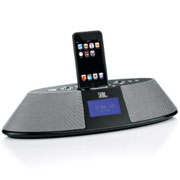
|
contents | hardware | |||||||
| JBL Unveils the JBL On Time 400IHD Digital Sound System  JBL has introduced the JBL On Time 400IHD digital sound system. The system features the digital clarity of HD Radio AM and FM reception, and has FM multicasting capability, an iPod dock and a clock with dual alarms. Connected to any docking iPod, MP3 player or other music source, the JBL On Time 400IHD provides a full, rich sound field from any direction, while its intuitive user interface makes it easy to operate. With the JBL On Time 400IHD system, music lovers can now listen – without a subscription fee – to static-free reception on HD Radio stations with FM sound as sensational as that found on CDs, and with AM sound as rich as analog FM stereo's. In addition, the JBL On Time 400IHD system can store "live" song information from select HD Radio stations with the push of a "Tag" button. That song "wish list" may be downloaded to the iPod the next time the iPod is docked in the system. When the iPod is next connected to iTunes, the "wish list", as well as the option to purchase the listed songs, will be displayed. With iTunes Tagging, listeners will never again have to scramble to write down a new song title or artist heard on the radio. JBL has introduced the JBL On Time 400IHD digital sound system. The system features the digital clarity of HD Radio AM and FM reception, and has FM multicasting capability, an iPod dock and a clock with dual alarms. Connected to any docking iPod, MP3 player or other music source, the JBL On Time 400IHD provides a full, rich sound field from any direction, while its intuitive user interface makes it easy to operate. With the JBL On Time 400IHD system, music lovers can now listen – without a subscription fee – to static-free reception on HD Radio stations with FM sound as sensational as that found on CDs, and with AM sound as rich as analog FM stereo's. In addition, the JBL On Time 400IHD system can store "live" song information from select HD Radio stations with the push of a "Tag" button. That song "wish list" may be downloaded to the iPod the next time the iPod is docked in the system. When the iPod is next connected to iTunes, the "wish list", as well as the option to purchase the listed songs, will be displayed. With iTunes Tagging, listeners will never again have to scramble to write down a new song title or artist heard on the radio.The JBL On Time 400IHD system combines multiple proprietary technologies for exceptional sound. Clean and compact digital amplification, coupled with digital-signal-processing equalization, efficiently provides the system's two Phoenix transducers with a clean, powerful soundstage. And its Slipstream port design minimizes distortion while optimizing bass output. The JBL On Time 400IHD system also provides power to charge and sync an iPod, even when the system is off or not connected to a computer. The JBL On Time 400IHD is compatible with most docking versions of the iPod. A stereo mini jack connection also allows you to enjoy high-quality audio from a variety of other devices, including MP3 and CD players, desktop computers (all platforms), satellite radio and laptops. The JBL On Time 400IHD system will be available in Spring 2008. write your comments about the article :: © 2008 Computing News :: home page |